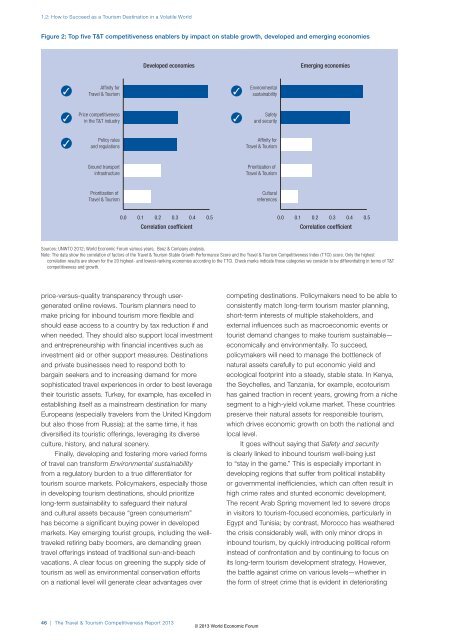The Travel & Tourism Competitiveness Report 2013
The Travel & Tourism Competitiveness Report 2013
The Travel & Tourism Competitiveness Report 2013
Create successful ePaper yourself
Turn your PDF publications into a flip-book with our unique Google optimized e-Paper software.
1.2: How to Succeed as a <strong>Tourism</strong> Destination in a Volatile World<br />
Figure 2: Top five T&T competitiveness enablers by impact on stable growth, developed and emerging economies<br />
✓<br />
✓<br />
✓<br />
Affinity for<br />
<strong>Travel</strong> & <strong>Tourism</strong><br />
Price competitiveness<br />
in the T&T industry<br />
Policy rules<br />
and regulations<br />
Ground transport<br />
infrastructure<br />
Prioritization of<br />
<strong>Travel</strong> & <strong>Tourism</strong><br />
Developed economies<br />
✓<br />
✓<br />
Environmental<br />
sustainability<br />
Safety<br />
and security<br />
Affinity for<br />
<strong>Travel</strong> & <strong>Tourism</strong><br />
Prioritization of<br />
<strong>Travel</strong> & <strong>Tourism</strong><br />
Cultural<br />
references<br />
Emerging economies<br />
0.0 0.1 0.2 0.3 0.4 0.5<br />
0.0 0.1 0.2 0.3 0.4 0.5<br />
Correlation coefficient Correlation coefficient<br />
Sources: UNWTO 2012; World Economic Forum various years; Booz & Company analysis.<br />
Note: <strong>The</strong> data show the correlation of factors of the <strong>Travel</strong> & <strong>Tourism</strong> Stable Growth Performance Score and the <strong>Travel</strong> & <strong>Tourism</strong> <strong>Competitiveness</strong> Index (TTCI) score. Only the highest<br />
correlation results are shown for the 20 highest- and lowest-ranking economies according to the TTCI. Check marks indicate those categories we consider to be differentiating in terms of T&T<br />
competitiveness and growth.<br />
price-versus-quality transparency through usergenerated<br />
online reviews. <strong>Tourism</strong> planners need to<br />
make pricing for inbound tourism more flexible and<br />
should ease access to a country by tax reduction if and<br />
when needed. <strong>The</strong>y should also support local investment<br />
and entrepreneurship with financial incentives such as<br />
investment aid or other support measures. Destinations<br />
and private businesses need to respond both to<br />
bargain seekers and to increasing demand for more<br />
sophisticated travel experiences in order to best leverage<br />
their touristic assets. Turkey, for example, has excelled in<br />
establishing itself as a mainstream destination for many<br />
Europeans (especially travelers from the United Kingdom<br />
but also those from Russia); at the same time, it has<br />
diversified its touristic offerings, leveraging its diverse<br />
culture, history, and natural scenery.<br />
Finally, developing and fostering more varied forms<br />
of travel can transform Environmental sustainability<br />
from a regulatory burden to a true differentiator for<br />
tourism source markets. Policymakers, especially those<br />
in developing tourism destinations, should prioritize<br />
long-term sustainability to safeguard their natural<br />
and cultural assets because “green consumerism”<br />
has become a significant buying power in developed<br />
markets. Key emerging tourist groups, including the welltraveled<br />
retiring baby boomers, are demanding green<br />
travel offerings instead of traditional sun-and-beach<br />
vacations. A clear focus on greening the supply side of<br />
tourism as well as environmental conservation efforts<br />
on a national level will generate clear advantages over<br />
46 | <strong>The</strong> <strong>Travel</strong> & <strong>Tourism</strong> <strong>Competitiveness</strong> <strong>Report</strong> <strong>2013</strong><br />
competing destinations. Policymakers need to be able to<br />
consistently match long-term tourism master planning,<br />
short-term interests of multiple stakeholders, and<br />
external influences such as macroeconomic events or<br />
tourist demand changes to make tourism sustainable—<br />
economically and environmentally. To succeed,<br />
policymakers will need to manage the bottleneck of<br />
natural assets carefully to put economic yield and<br />
ecological footprint into a steady, stable state. In Kenya,<br />
the Seychelles, and Tanzania, for example, ecotourism<br />
has gained traction in recent years, growing from a niche<br />
segment to a high-yield volume market. <strong>The</strong>se countries<br />
preserve their natural assets for responsible tourism,<br />
which drives economic growth on both the national and<br />
local level.<br />
It goes without saying that Safety and security<br />
is clearly linked to inbound tourism well-being just<br />
to “stay in the game.” This is especially important in<br />
developing regions that suffer from political instability<br />
or governmental inefficiencies, which can often result in<br />
high crime rates and stunted economic development.<br />
<strong>The</strong> recent Arab Spring movement led to severe drops<br />
in visitors to tourism-focused economies, particularly in<br />
Egypt and Tunisia; by contrast, Morocco has weathered<br />
the crisis considerably well, with only minor drops in<br />
inbound tourism, by quickly introducing political reform<br />
instead of confrontation and by continuing to focus on<br />
its long-term tourism development strategy. However,<br />
the battle against crime on various levels—whether in<br />
the form of street crime that is evident in deteriorating<br />
© <strong>2013</strong> World Economic Forum

















